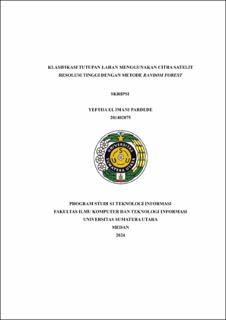| dc.description.abstract | Rapid urban growth has significantly altered its geographical characteristics, particularly in urban areas where changes in land use and infrastructure are highly noticeable. These geographical changes, especially in land use, necessitate continuous monitoring. Leveraging technological advancements, environmental changes in Medan city can be monitored to support sustainable development efforts. This study employs the Random Forest algorithm, known for handling spectral variability in satellite imagery data. The data used consists of Sentinel-2 satellite images, specifically Band 2, Band 3, Band 4, and Band 8, chosen for their 10-meter spatial resolution, which is instrumental in producing high-resolution classifications. The dataset comprises 167 polygons, broken down into thousands of pixels. This data is divided into training data (70%), test data (20%), and validation data (10%). The Random Forest model is trained and evaluated using this data to classify the imagery into six land cover types: vegetation, urban areas, water bodies, open land, agricultural land, and roads. The final results reveal that the Random Forest model achieved an overall accuracy of 97.33%. High precision, recall, and F1 scores for each class demonstrate the model's capability to accurately identify various types of land cover. | en_US |


